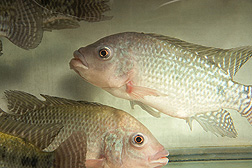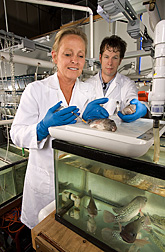Genetic Research Sheds Light
on Group BStreptococcus
|
|
A versatile pathogen that affects a variety of animals, Streptococcus agalactiae has a family tree that might have baffled Darwin himself. Fortunately, new research from the Agricultural Research Service is shedding light on the relatedness of subtypes of the bacteria that affect different animals.
Probably best known for causing mastitis in cattle and neonatal meningitis in humans, S. agalactiae (also called group B Streptococcus, or GBS) has also been known to infect reptiles, amphibians, and fish.
The symptoms of GBS, a relative of the group A Streptococcus species that causes strep throat in humans, vary from animal to animal. Human adult carriers of GBS generally have no symptoms, but the bacteria can be deadly for newborns that contract it in the birth canal. In cattle, GBS is associated with mastitis—a painful udder inflammation that costs the U.S. cattle industry about $2 billion annually. In farmed and wild fish, the bacteria can cause meningoencephalitis, which is accompanied by swimming difficulty and hemorrhaging.
|
|
There are no official records of the disease’s economic impact, but ARS researchers estimate that GBS may cause significant losses for the aquaculture industry. The bacteria have infected wild fish around the world. And incidences of GBS in farmed fish have increased in frequency since the bacteria were first observed in U.S. hatcheries in 1966, prompting researchers to investigate how fish contract the disease and pass it on.
Can the disease be spread from one host species to another? Which types of GBS infect multiple species? To address these questions and learn more about the emergence and transmission of GBS, scientists with the Aquatic Animal Health Research Unit, in Auburn, Alabama, and Chestertown, Maryland, compared GBS samples, or “isolates,” collected from a variety of infected animals from around the world.
|
|
“Understanding the global distribution, host susceptibility, and genetic relatedness of GBS isolates is essential for understanding GBS disease in fish and marine mammals,” says aquatic pathologist Joyce Evans, who led the study.
With ARS research leader Phillip Klesius, professor John Bohnsack of the University of Utah, and professor Shinji Takahashi of Japan’s Joshi-Eiyoh University, Evans gathered GBS isolates from several fish species in the United States, Latin America, and the Middle East; a bottlenose dolphin in Kuwait; humans and cattle in North America; and humans in Japan.
The scientists used a technique known as “multilocus sequence typing” (MLST) to examine similarities and differences between the genes of the GBS isolates. This was the first study to apply the technology to GBS isolates from aquatic animals and to compare those isolates to human and bovine GBS isolates.
“MLST is particularly suitable for epidemiological studies like this because it provides data that can easily be compared between laboratories over the World Wide Web,” Evans says.
She and her colleagues have shared their GLB MLST data online at http://pubmlst.org/sagalactiae/.
Genetic Analysis Reveals Lineage Data
During characterization of the GBS isolates, the scientists discovered a previously unknown serotype in fish in isolates from Kuwait, Brazil, Israel, and the United States. “Serotypes” are closely related subdivisions of microorganisms, each of which has a unique set of antigens that distinguishes it from the others. Although this particular serotype had never before been observed in fish or dolphin GBS isolates, it had been found in some cattle and human GBS isolates.
Using MLST data, Evans and her colleagues also discovered five previously unknown sequence types that were genetically unrelated to any known GBS sequence types. Both findings are significant because they could shed light on the relatedness and potential evolutionary relationship of these particular isolates.
In a related study, the scientists also showed that a human GBS isolate—one with the same serotype and sequence type as those found in fish—is capable of causing infection in fish. In this study, Evans and Klesius exposed Nile tilapia to a human GBS isolate responsible for human neonatal infections in Japan and observed that the fish developed disease symptoms and died. This proves that human GBS can be pathogenic to fish in a laboratory setting. But there is no proof that wild fish have been infected with GBS of human origin.
“Genetic analyses alone cannot determine whether GBS is capable of being passed from one species to another and causing disease,” Klesius says. “But they can indicate whether it is a possibility.”
Further research is needed to determine whether human GBS isolates are capable of infecting fish in natural settings and whether other human GBS isolates can infect and kill fish.
So are fish susceptible to bovine GBS as well? That remains to be seen. In the laboratory, Evans and her colleagues exposed tilapia to bovine GBS isolates, but the fish did not develop infection symptoms. But this does not mean that it is impossible for bovine GBS isolates to infect fish. Evans and her colleagues plan to repeat the experiment with a different serotype of the bacteria.
All of this information can be used to improve aquaculture scientists’ understanding of potential sources and reservoirs of this important disease. The data generated from these studies has been added to the GBS MLST database, where it can be used by researchers investigating human, bovine, and aquatic animal GBS.—By Laura McGinnis, Agricultural Research Service Information Staff.
This research is part of Aquaculture, an ARS national program (#106) described on the World Wide Web at www.nps.ars.usda.gov.
Joyce Evans is in the USDA-ARS Aquatic Animal Health Research Unit, 118 B South Lynchburg St., Chestertown, MD 21620-1115; phone (410) 778-2120, fax (410) 778-4399.
"Genetic Research Sheds Light on Group B Streptococcus" was published in the August 2009 issue of Agricultural Research magazine.









